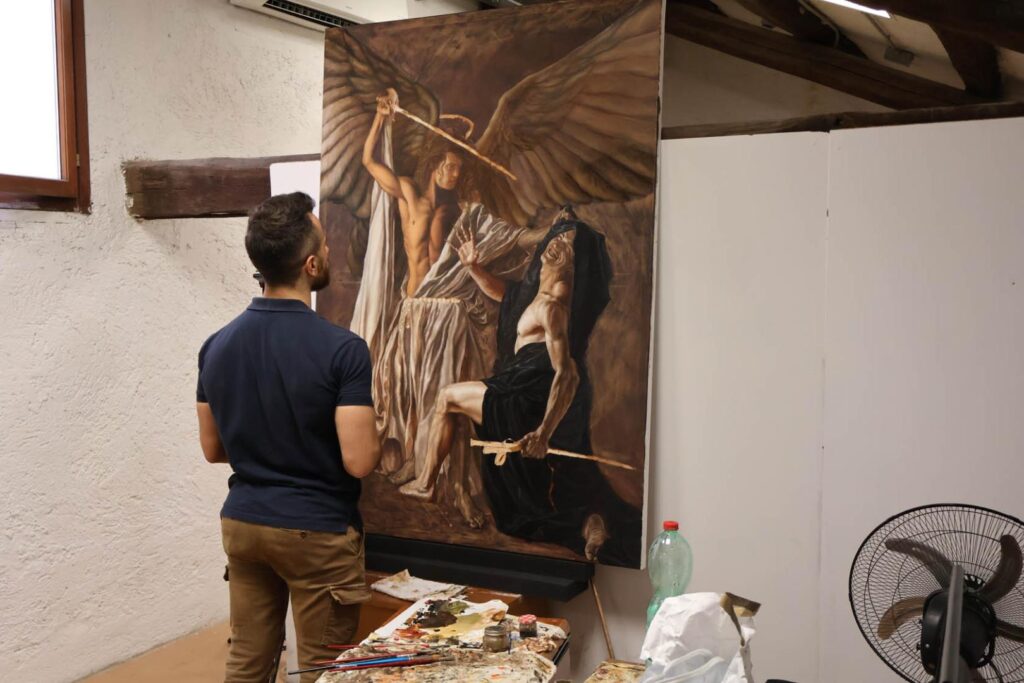
Born in Albano Laziale in June 1989, he showed a natural interest in artistic expression in all its forms from a very early age, gravitating towards music and drawing rather than conventional games. Despite this early inclination, his family decided to steer him towards a more “traditional” education. He obtained a classical high school diploma and later a master’s degree in Law, complemented by a Master in English. The urgent need to express himself more fully and freely led him back to music, and he secured a recording contract that took him into the world of professional musicians for two years. After leaving this path, he practiced law independently before taking on the role of administrative manager of one of the sections of the INFN. Stricken by a severe illness that put his life at risk, he miraculously regained his health and rediscovered the beauty in the works of the great masters of the past. Self-taught, he once again followed his original artistic inclination, painstakingly rediscovered, by returning to drawing and oil painting. Since then, he has devoted his time exclusively to art, quickly becoming a favored artist of the Ministry of the Interior and the State Police. As an agent within this administration, he transforms the values that drive the men and women in uniform every day into works of art, aiming to bring the community closer to the State Police. Through dedication, he eventually became a student of the great Italo-Brazilian master Gilberto Geraldo, a professor at the Repin Academy in St. Petersburg, from whom he studied the motifs, techniques, and philosophy of classical academic art.
Matteo Plini, an artist from Lazio born in ’89, arrived at art through a multifaceted, sometimes adventurous, personal journey. Growing up among legal codes and manuals, he developed a dedication and a research attitude that he fully transferred to the study of artists’ lives and fine arts manuals. His personal training took place outside the academy walls, even though it is in that ideal context that he found his source of inspiration. His hand, educated by the obsessive study of the great masters and guided by the pursuit of the classical ideal of beauty, clearly demonstrates the intention to create images that, in a dance of symbols and meanings, are primarily genuinely beautiful. Plini has perfectly grasped the capacity of beauty to become a catalyst for meaning; not an end point but rather a messenger of the conceptual research on which every contemporary artwork is founded. Perhaps favored by such a varied personal journey, Plini never exhibits the sense of reverential fear that deters many young artists from an ancient and historically rich medium like painting. His works are rich with suggestions and references to the great masters that adapt to a personal search mixing classical and Buddhist iconographies, Russian portraiture with Zen parables. It is precisely the perfect coexistence of seemingly distant cultures that is the most interesting key to interpreting Plini’s works. Multiculturalism, which has marked the roots of our history but which we have curiously ended up forgetting to the point of having to fiercely defend a value that in Roman times was simply the norm, is a significant theme. Matteo Plini’s work lives in the contemporary but in historical attire; he portrays the street vendors of Piazza Vittorio as Hindu deities or Roman emperors, describes the dramas and weaknesses of the world we live in on canvases prepared with rabbit glue, constantly seeking a synthesis between naturalism, classicism, and the great symbolic themes of metaphysical philosophy. A blog in hendecasyllables to make us reflect on the fact that contemporaneity should be sought in the message, not in the syntax.
His works are present in institutional collections, such as: Quirinale, Apostolic Palace at the Vatican, Senate of the Republic, Vatican Prefecture, Palazzo del Viminale and numerous private collections of eminent personalities of the State and Church such as the dean at the Vatican and ambassador of Cyprus, some European Commissioners, the Secretary General of the Quirinale, former Presidents of the Council of Ministers and Honorable Members.
The spirit is the door through which man is allowed to rise and yearn for the infinite. But the duality of this world must be fully embraced, seeing God and Beauty in everything.
